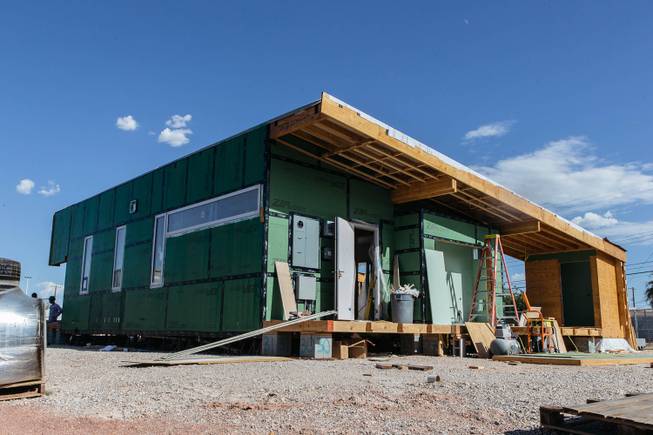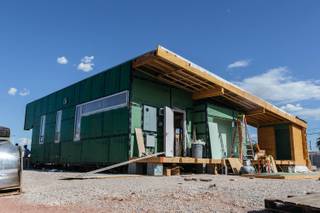
Construction continues on UNLV’s 990-square-foot home in Las Vegas, Nev. on August 28, 2017. The house will be entered in the international 2017 U.S. Department of Energy Solar Decathlon later this year.
Tuesday, Sept. 5, 2017 | 2 a.m.
Related Coverage
Building a house with no prior experience is tough enough, but imagine constructing one knowing that you would soon have to split it into multiple parts and transport it out of state.
That is just part of the challenge that 30 UNLV students face as they prepare for the U.S. Department of Energy’s Solar Decathlon 2017 competition next month. The winning school takes home $300,000.
The crew is building a 990-square-foot solar-powered home, dubbed “Sinatra Living,” integrating the latest technology and energy-efficient features.
The engineering and architecture students have day and night shifts, and they work around each other's school and work schedules. Various community partners throughout the valley have assisted.
“It’s not just what you learn in the classroom, it’s what you learn outside of it a lot more sometimes,” said Rama Venkat, dean of the Howard R. Hughes College of Engineering. “What they’re learning in the classroom, they're bringing it to practice, in terms of the house They get to work among themselves and learn leadership qualities.
Each of the 13 teams in the competition chose a target market for their home. UNLV chose the elderly population. Nationally, it is projected that by 2030 one out of every five people in the United States will be 65 or older.
“We’ve seen a huge, growing demographic of people 65 years old and older … and we wanted to offer a housing solution that can deal with some of the needs of someone who is retiring,” said Nasko Balaktchiev, project manager and second-year architecture student.
The entire home is wheelchair accessible, which wasn’t the easiest design feature to implement, according to Balaktchiev.
“We’ve gone through almost 100 different floor plan variations to figure out how we can maximize the amount of livable square footage,” he said. “We also had to make sure it was a transportable home, since we have to disable and transport it.”
To help ensure they meet the needs of the elderly, the students went to Las Ventanas Retirement Community in the western part of the valley and spoke with residents. They also conducted a focus group with members of the American Association of Retired Persons to assess what seniors seek in a dream retirement home.
The latest technology was integrated into the house, Balaktchiev said, including the Amazon Alexa personal assistant system.
“Accessibility is a huge feature of the home, so we have a lot of moveable items and devices that can be interacted with,” said Adam Betemedhin, project engineer. “They can be in any room, and they can use voice commands to get status updates on the home as well as being able to command things.”
That system can be used to control temperature and the home's movable features (outdoor sun shades, indoor shutters, etc.). It can be used to monitor water/energy use and make phone calls. The lighting system automatically balances artificial and natural lighting to save energy. Adjustable counters allow for wheelchair access.
Through a partnership with Amazon Web Service, users will be able to track how their energy consumption changes over time.
“It really gives you an understanding of the full environment in your home and the environment that's surrounding it,” Betemedhin said.
Power from the rooftop solar panels is fed into a back-up panel in the form of a Tesla Powerwall 2.0, a 13.2-kilowatt battery.
“We use that to mitigate how much energy we’re using in the middle of the day by using stored energy to reduce costs,” Balaktchiev said.
The Tesla Powerwall 2.0 serves as the home’s back-up power source if there is a grid outage.
“The Tesla battery could power the home for a couple of days, depending on how much energy the home is consuming, Balaktchiev said.
Tesla is loaning UNLV an electric vehicle to display with the home’s electric-car charging port during the competition.
When the home is ready to be transported to Colorado for the competition next month, the home will be split in half. The patio on the south portico of the home also can be disassembled from the house.
The team will begin to disassemble the home a week before the Sept. 20 departure date. It will take three-four days to arrive in Denver. Then the students will have nine days to assemble the house to ensure all aspects are working correctly before the competition begins Oct. 5.
With the team taking second place in 2013, this year's squad is aiming for the top spot.
“We’re really hoping so (to win first place),” Balaktchiev said. “We’ve got a really competitive house concept and we’re ready to compete and see how we do.”
A send-off celebration is set for 4:30 p.m. Thursday. The project is made possible by donations from various companies. The goal is to raise $1 million for the cost of the project and the transportation of the home, travel and lodging for the students.
So far they have raised $750,000. Prospective sponsors can donate online via Rebel Raiser. Or go here to discover additional ways to donate.


Join the Discussion:
Check this out for a full explanation of our conversion to the LiveFyre commenting system and instructions on how to sign up for an account.
Full comments policy